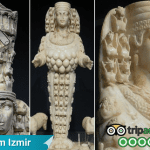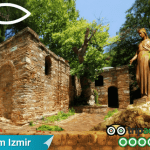Quick Summary
The Temple of Hadrian is located on Curetes Street in Ephesus and was built around 138 A.D. by a wealthy Ephesian P. Quintillus. A statue of Tyche (goddess of good fortune), adorns the central stone of the arch. The semi-circular pediment above them features a so-called Medusa figure. The original friezes, now in the Ephesus Archaeological Museum in Selcuk-Turkey, depict gods, goddesses, and scenes from Ephesus’s founding and mythology. The temple was restored in the 4th century after an earthquake.
Table of contents
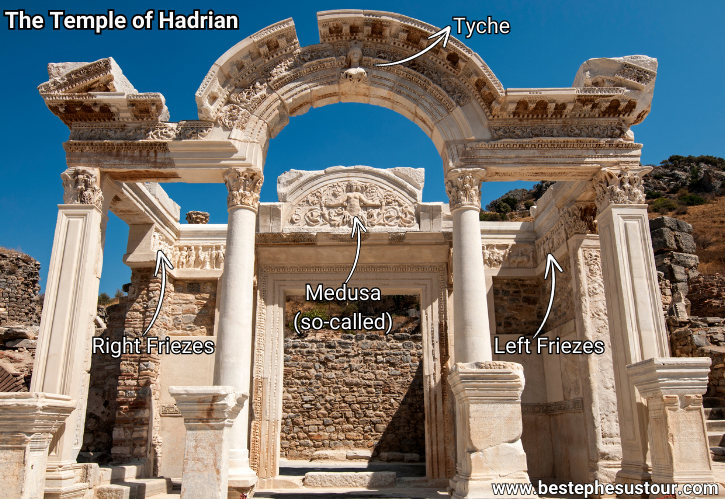
The Temple of Hadrian is one of the most stunning structures on famous Curetes Street in Ephesus. It is estimated to have been built in 138 A.D. The architecture of the front wall and pronaos (the porch leading to the temple) is very elaborate, while the naos (the inner chamber) is relatively plain, being made of small stones.
The Temple of Hadrian Video
Architectural Features
In front of the pronaos are four columns with Corinthian capitals supporting the triangular pediment. These pediments form an arch, similar to Syrian pediments, on the two middle columns. The central stone of the arch features a statue of Tyche the goddess of good fortune.
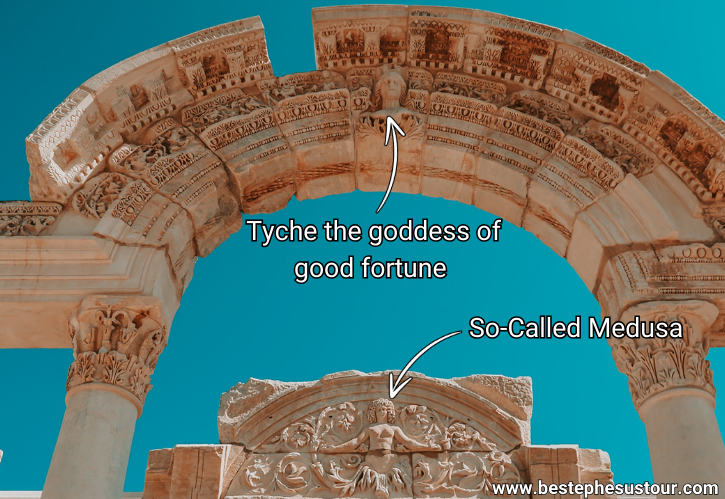
Despite the small size of the temple, the doors are very large, with richly decorated beams featuring classical designs such as rows of pearls and eggs. On the semi-circular second pediment is a nude figure of the so-called Medusa amidst leaves and flowers.
Friezes and Decorations
The original friezes on both sides of the upper beam on the door of the pronaos are housed in the Ephesus Archaeological Museum in Selcuk-Turkey, with copies placed here during restoration. The subjects of the first three friezes (from the left) are:
- Some gods and goddesses.
- The chasing of a boar by the horse-mounted founder of Ephesus.
- Gods and Amazons, Amazons, and the Dionysus procession.
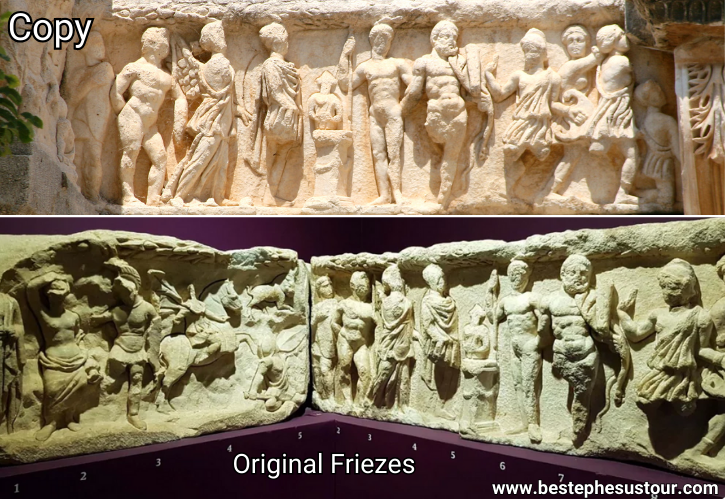
The fourth frieze has a different theme, depicting Apollo, Athena, Androclus, and Heracles, Androcles (The founder of Ephesus), the father of Theodosius, Emperor Theodosius, the Artemis of Ephesus, the wife and son of Theodosius.
Temple of Hadrian’s Restoration and Dedication
The temple was restored after being damaged by an earthquake in the middle of the 4th century A.D. During the restoration, the fourth frieze was recreated and put in place. The temple was originally dedicated to Emperor Hadrian by P. Quintillus in 138 A.D.
Emperors’ Pedestals
The four inscribed pedestals in front of the temple’s columns belong to the four emperors who ruled the Roman Empire during the same period. According to the inscriptions, these emperors are Diocletian, Maximian, Constantius Chlorus, and Galerius (293-305 A.D.).
Religious Role of the Temple of Hadrian
The Temple of Hadrian was more than just a building; it was a hub of religious and cultural activity in Ephesus. The temple was a place of worship and a gathering spot for citizens, especially during the Ephesian Artemis procession. It played a key role in the religious and social life of the city.
The Temple of Hadrian After Dark

The ancient city of Ephesus is open until 24:00 and the city and buildings are illuminated after 19:00. Hadrian’s Temple is one of the uniquely beautiful illuminated structures in Ephesus.
Emperor Hadrian: Background and Early Life
Hadrian, the third of the five so-called “Good Emperors” of the Roman Empire. He was born on January 24, 76 A.D. in the Roman province of Hispania Baetica. His parents were Publius Aelius Hadrianus and Domitia Paulina. Despite being born into a relatively humble family, his father’s position as a Roman senator set the stage for Hadrian’s promising future. Hadrian had a beloved sister who later married Emperor Trajan.
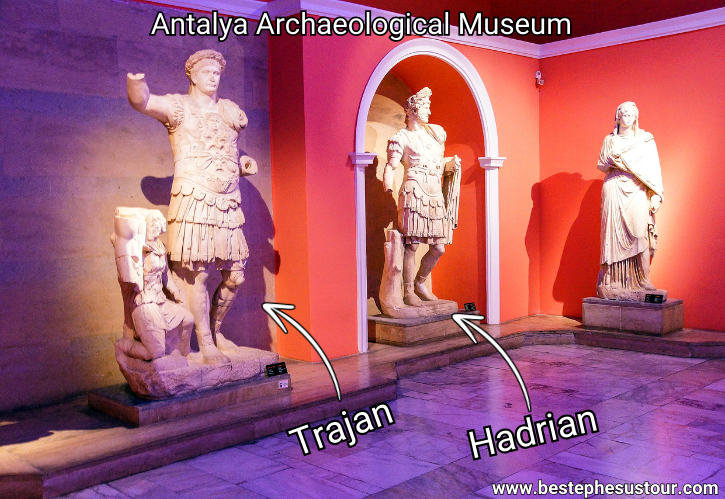
Education and Ambition
Hadrian received a privileged education, studying rhetoric and law during his childhood and youth. He was ambitious from a young age, aspiring for power and glory. This ambition was evident in his dedication to his studies and later in his military career.
Military Career and Ascension to Emperor
Hadrian served in the Roman army in Germany and Britain, gaining valuable military experience. His talents and connections eventually led to his ascension as emperor on July 10, 117 A.D., at the age of 41. His reign lasted for 21 years, during which he made significant contributions to the Roman Empire.
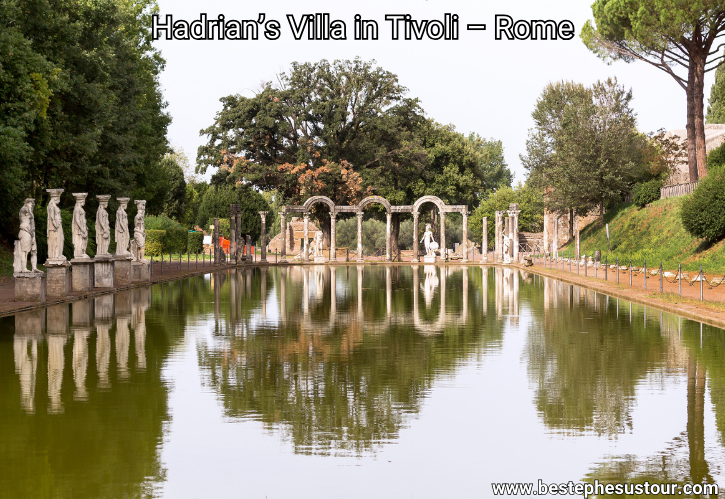
Hadrian’s Achievements as Emperor
Hadrian is widely regarded as one of Rome’s greatest emperors. He is best known for his construction of Hadrian’s Wall in northern England, which marked the northern boundary of the Roman Empire in Britain. Additionally, Hadrian was known for his military conquests, extensive public building projects, and the establishment of an extensive road network throughout the empire. These contributions greatly enhanced the infrastructure and defense of the Roman Empire.
Hadrian’s Death and Legacy
After a successful reign, Hadrian died in 138 A.D. at the age of 62. His legacy includes not only his physical contributions to the empire’s infrastructure but also his reputation as a wise and effective ruler who greatly influenced the prosperity and stability of the Roman Empire.




